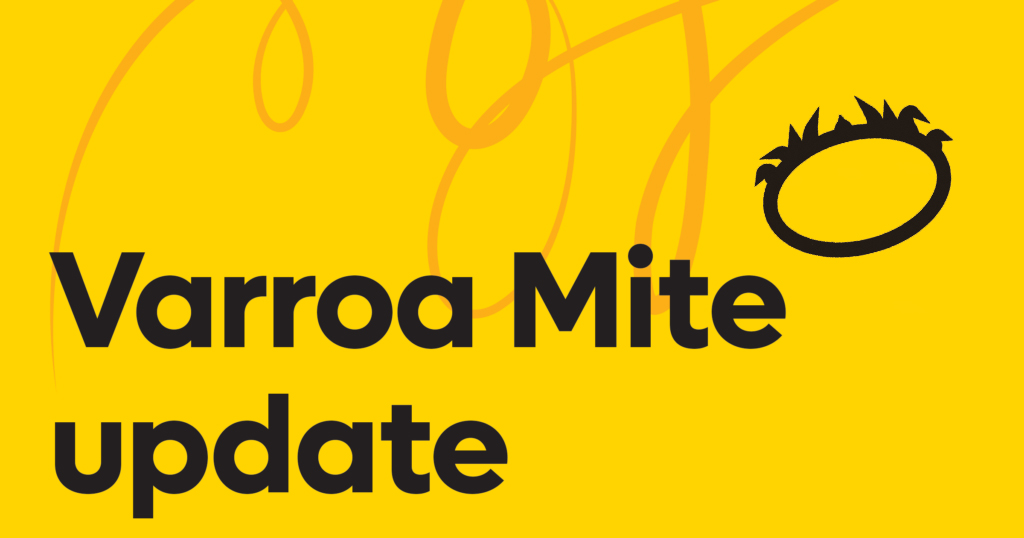AHBIC Industry Update 47 – 464 days of response
29 September 2023NSW Beekeepers Alcohol Washing Alcohol washing hives to check for mites is regulated and should at the very least be completed and reported every 16 weeks as per the Emergency […]

NSW Beekeepers
Alcohol Washing
Alcohol washing hives to check for mites is regulated and should at the very least be completed and reported every 16 weeks as per the Emergency Order across GREEN and ORANGE Zones, 10 hives each apiary or 10% whichever is greater.
Beekeepers are reminded to report any suspect Varroa found in alcohol washes to the Department as per the Emergency Order. Those who report Varroa will receive details from the DPI regarding access to chemistry for treatment.
AHBIC stresses to beekeepers that the “minimum” requirements under the Emergency Order are the “minimum” beekeepers should be conducting and reporting. To truly understand if mites are present within the colonies you are in charge of, we recommend beekeepers undertake as many alcohol washes per apiary as possible, as monitoring for mites is a foundation for beekeeping with Varroa.
Movement Declarations
Movement is allowed within the GREEN zone of NSW. All beekeepers must submit a hive movement declaration and comply with their minimum alcohol wash activities and reporting.
Management Zones
Beekeepers must continue to comply with the alcohol wash activities and reporting. For clarification on specific rules of activities, including access to treatment, crossing zones and operating within the management zone beekeepers should seek specific advice directly from the DPI.
Transition plans
The Decision
On 19th September the National Management Group (NMG) decided that it was no longer technically feasible to eradicate Varroa. There were many reasons why this decision was made including but not limited to:
The Kempsey cluster presenting a number of historical hive movements out of Kempsey into the blue zone before the detection. These traces created many additional detections across NSW adding complexities for the response.
At the time of the decision there were 30,000 hives destroyed and an additional 52,000 hives in red zones to be destroyed, 82,000 in total. This represented 21% of all the hives in NSW and 10% of the national hive numbers. That number was also expected to grow as more of the Kempsey trace premises were assessed.
The size of the response had grown from 1,300 sq./km to 7,500 sq./km in the space of a few months due to the traces from Kempsey cluster. The resourcing requirements, both in personnel and money to continue effectively eradicating across such a large area also contributed to the decision.
Diminishing social license and response fatigue by the NSW beekeepers was compromising the response’s ability to ensure success. This was demonstrated by the declining alcohol wash reports being received by the DPI.
Transition to Management plan
The response will now pivot from eradication to a phase of transition to management and will focus on slowing the spread and preparing beekeepers for living with Varroa. A CCEPP workshop was held in Canberra with all affected parties to work through the components of this change in the response plan. Whilst historical high-level plans had been drafted in anticipation, a new way forward still needs to be negotiated and agreed to by all affected parties.
The process now is for the DPI to combine all the feedback from the workshop and develop a new version draft response plan over the next few weeks to have it presented back to CCEPP for agreement. Whilst speculating what the finer details of the new plan will look like is not helpful at this stage, there was strong agreement that it must be based around education and training of beekeepers and pollination dependent growers.
It is anticipated that the transition plan will fund the development of national training and delivery of workshops, factsheets and online content. There was strong agreement that this education delivery will be available to all Australian beekeepers in line with a national approach and once agreed, should begin as soon possible.
Chemical Treatments
Developing a pathway for a number of different treatment chemicals to reach retail markets, has already commenced. In the short term, miticides will only be supplied through the DPI, to those who have identified mites in their operation, to prevent a rush on supply. As treatments become available commercially, the DPI will transition away from supplying these products directly to beekeepers.
Full registrations for Apivar (amitraz) and Apiguard (thymol) are approved and ready to be imported. Applications for Bayvarol (flumethrin), Mite Away Quick Strips (formic acid) and an Oxalic acid product are in the APVMA system for assessment. In addition, there is a number of manufacturers also applying to have their products registered directly with the APVMA which will create many additional treatment options for beekeepers.
AHBIC has been advocating for additional chemical options to be made available for those wishing to use organic over synthetic treatments.
Mite spread
High mite loadings have been identified in feral colonies around the Central Coast with clean re-introduced colonies becoming infested within 3 weeks. At the start of the response mite loadings in this area were low and not detectable in the feral populations. It has taken 15 months for the mites to build into high levels in this area which is in line with expert advice on predicted build up.
The advice from experts has indicated that whilst there is likely to be low levels of mites in many areas across NSW they will take time to build in numbers. The experience in the Central Coast suggests it will take some time for the mites to build to levels that require treatment across NSW. It is anticipated that the commercial pathways for miticide supply will be established before there is high demand for treatments.
You can reach out to AHBIC via:
Varroa Coordinator
Bianca Giggins
0402 467 780
